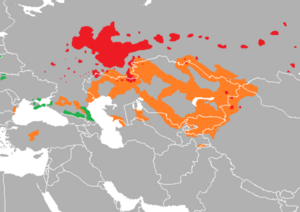Kipchak languages
| Kypchak | |
|---|---|
| Geographic distribution |  Kypchak-Bolgar Kypchak-Cuman Kazakh-Nogay |
| Linguistic classification | Turkic
|
| Subdivisions |
|
The Kypchak languages, a major branch of the Turkic language family, are spoken by more than 12 million people in an area spanning from Lithuania to China.
Linguistic Features
The Kypchak languages share a number of features that have led linguists to classify them together. Some of these features are shared with other Turkic languages; others are unique to the Kypchak language family.
- Change of Proto-Turkic *d to /j/ (e.g. *hadaq > ajaq "foot")
- Loss of initial *h sound (preserved only in Khalaj. See above example.)
Unique Features
- Extensive labial vowel harmony (e.g. olor vs. olar "them")
- Frequent affrication of initial /j/ (e.g. *jetti > ʒetti "seven")
Classification
The Kypchak languages may be broken down into three groups, based on geography and shared features:
- Kypchak-Bolgar (Uralo-Caspian), including Bashkir and Tatar (including Siberian Tatar, Mishar Tatar, Astrakhan Tatar, Baraba Tatar, etc.)
- Kypchak-Cuman (Ponto-Caspian), including Karachay-Balkar, Kumyk, Karaim, Krymchak, and the extinct Cuman and Kipchak languages. Urum and Crimean Tatar appear to have a Kypchak-Cuman base, but have been heavily influenced by Oghuz languages.
- Kazakh-Nogay, including Kazakh, Karakalpak, and Nogay
Literary Kyrgyz has been heavily influenced by the Kypchak languages, especially Kazakh, but it appears that it belongs in a separate family with Altay.
The Uzbek language's Kypchak dialect contains the remainder of Kypchak languages that were once spoken in Uzbekistan, and there is a dialect continuum between Uzbek and Kazakh.
The language of the Mamluks in Egypt appears to have been a Kypchak language, probably one belonging to the Kypchak-Cuman group.
See also
References
- Johanson, Lars and Csató, Éva Ágnes (1998). The Turkic Languages. London: Routledge. ISBN 0-415-08200-5.
{{cite book}}: CS1 maint: multiple names: authors list (link)
- Menges, Karl H. (1995). The Turkic Languages and Peoples. Wiesbaden: Harrassowitz. ISBN 3-447-03533-1.
